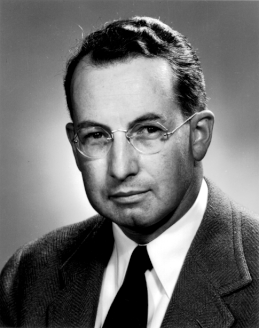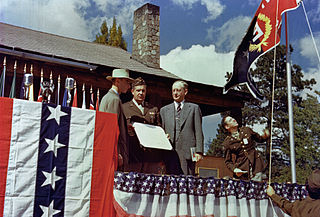Related Research Articles

J. Robert Oppenheimer was an American theoretical physicist who was professor of physics at the University of California, Berkeley. Oppenheimer was the wartime head of the Los Alamos Laboratory and is among those who are credited with being the "father of the atomic bomb" for their role in the Manhattan Project – the World War II undertaking that developed the first nuclear weapons. Oppenheimer was among those who observed the Trinity test in New Mexico, where the first atomic bomb was successfully detonated on July 16, 1945. He later remarked that it brought to mind words from the Bhagavad Gita: "Now I am become Death, the destroyer of worlds." In August 1945, the weapons were used in the atomic bombings of Hiroshima and Nagasaki.
Utopian and dystopian fiction are genres of speculative fiction that explore social and political structures. Utopian fiction portrays a setting that agrees with the author's ethos, having various attributes of another reality intended to appeal to readers. Dystopian fiction offers the opposite: the portrayal of a setting that completely disagrees with the author's ethos. Some novels combine both genres, often as a metaphor for the different directions humanity can take depending on its choices, ending up with one of two possible futures. Both utopias and dystopias are commonly found in science fiction and other types of speculative fiction.

Mad scientist is a stock character of a scientist who is described as "mad" or "insane" owing to a combination of unusual or unsettling personality traits and the unabashedly ambitious, taboo or hubristic nature of their experiments. As a motif in fiction, the mad scientist may be villainous or antagonistic, benign or neutral; may be insane, eccentric, or clumsy; and often works with fictional technology or fails to recognize or value common human objections to attempting to play God. Some may have benevolent intentions, even if their actions are dangerous or questionable, which can make them accidental antagonists.

Lieutenant General Leslie Richard Groves Jr. was a United States Army Corps of Engineers officer who oversaw the construction of the Pentagon and directed the Manhattan Project, a top secret research project that developed the atomic bomb during World War II.

Louis Whitley Strieber is an American writer best known for his horror novels The Wolfen and The Hunger and for Communion, a non-fiction account of his alleged experiences with non-human entities. He has maintained a dual career of author of fiction and advocate of paranormal concepts through his best-selling non-fiction books, his Unknown Country web site, and his Internet podcast, Dreamland.

Richard Lee Rhodes is an American historian, journalist, and author of both fiction and non-fiction, including the Pulitzer Prize-winning The Making of the Atomic Bomb (1986), and most recently, Energy: A Human History (2018).

Robert Fox Bacher was an American nuclear physicist and one of the leaders of the Manhattan Project. Born in Loudonville, Ohio, Bacher obtained his undergraduate degree and doctorate from the University of Michigan, writing his 1930 doctoral thesis under the supervision of Samuel Goudsmit on the Zeeman effect of the hyperfine structure of atomic levels. After graduate work at the California Institute of Technology (Caltech) and the Massachusetts Institute of Technology (MIT), he accepted a job at Columbia University. In 1935 he accepted an offer from Hans Bethe to work with him at Cornell University in Ithaca, New York, It was there that Bacher collaborated with Bethe on his book Nuclear Physics. A: Stationary States of Nuclei (1936), the first of three books that would become known as the "Bethe Bible".

Henry DeWolf "Harry" Smyth was an American physicist, diplomat, and bureaucrat. He played a number of key roles in the early development of nuclear energy, as a participant in the Manhattan Project, a member of the U.S. Atomic Energy Commission (AEC), and U.S. ambassador to the International Atomic Energy Agency (IAEA).
Tuckerization is the act of using a person's name in an original story as an in-joke. The term is derived from Wilson Tucker, a pioneering American science fiction writer, fan and fanzine editor, who made a practice of using his friends' names for minor characters in his stories. For example, Tucker named a character after Lee Hoffman in his novel The Long Loud Silence, and after Walt Willis in Wild Talent.

Warday is a novel by Whitley Strieber and James Kunetka, first published in 1984. It is a fictional account of the authors travelling across the U.S. five years after a limited nuclear attack in order to assess how the nation has changed after the war. The novel takes the form of a first-person narrative research article and includes government documents, interviews with survivors and aid workers, and present-tense narration.
Hunger is a prolonged condition in which insufficient amounts of food are available.

Communion: A True Story is a book by American ufologist and horror author Whitley Strieber that was first published in February 1987. The book is based on the experiences of Whitley Strieber, who experiences "lost time" and terrifying flashbacks, which hypnosis undertaken by Budd Hopkins later links to an alleged encounter with aliens. Communion was a nonfiction best seller for six months in 1987.

Jim Ottaviani is an American writer who is the author of several comic books about the history of science. His best-known work, Two-Fisted Science: Stories About Scientists, features biographical stories about Galileo Galilei, Isaac Newton, Niels Bohr, and several stories about physicist Richard Feynman. He is also a librarian and has worked as a nuclear engineer.

The Beginning or the End is a 1947 American docudrama film about the development of the atomic bomb in World War II, directed by Norman Taurog, starring Brian Donlevy, Robert Walker, and Tom Drake, and released by Metro-Goldwyn-Mayer. The film dramatizes the creation of the atomic bomb in the Manhattan Project and the bombing of Hiroshima.
Lightning has long been used as a dramatic device in popular fiction. A non-nuclear EMP (NNEMP) device appeared as early as 1965, in the Thunderbirds TV puppet show. By the early 1980s, a number of articles on nuclear electromagnetic pulse (NEMP) in the popular press spread knowledge of the EMP phenomenon into the popular culture. EMP has been subsequently used in a wide variety of fiction and other aspects of popular culture.

James Edward Westcott was an American photographer who was noted for his work with the United States government in Oak Ridge, Tennessee, during the Manhattan Project and the Cold War.
Joyce Clennam Stearns was an American physicist and an administrator on the Manhattan Project. He served as the Director of the Metallurgical Laboratory at the University of Chicago from November 1944 through July 1945.

The Los Alamos Laboratory, also known as Project Y, was a secret laboratory established by the Manhattan Project and operated by the University of California during World War II. Its mission was to design and build the first atomic bombs. Robert Oppenheimer was its first director, serving from 1943 to December 1945, when he was succeeded by Norris Bradbury. In order to enable scientists to freely discuss their work while preserving security, the laboratory was located in a remote part of New Mexico. The wartime laboratory occupied buildings that had once been part of the Los Alamos Ranch School.
Marie D. Jones was born Marie D. Savino in Bridgeport, Connecticut in 1961. She is an American author of non-fiction and fiction, a screenwriter, and indie filmmaker. She is also a paranormal researcher, a former radio show host, and has appeared on television. Her work has appeared in dozens of magazines, online publications, reviews, and blogs. She has contributed to over 50 inspirational gift books for Publications International and New Seasons, and she has written Forewords and chapters for several other writer’s books, and has contributed stories to several Chicken Soup for the Soul books.
References
- ↑ David Seed (31 October 2013). American Science Fiction and the Cold War: Literature and Film. Taylor & Francis. pp. 175–. ISBN 978-1-135-95389-8.
- 1 2 "The General and the Genius: Groves and Oppenheimer— The Unlikely Partnership That Built the Atom Bomb". Publishers Weekly
- ↑ "ABQ native’s book examines relationship of two key figures behind the Manhattan Project". Albuquerque Journal , By David Steinberg, August 23rd, 2015
- ↑ "NEW FILM ON EFFECTS OF NUCLEAR WAR IS PLANNED". New York Times, By Aljean Harmetz, November 14, 1983
- ↑ "Sweet Charity". Texas Monthly , September 2000 By Patricia McConnico
- ↑ "The partnership behind the atomic bomb". Trib Live, Alan Wallace | Saturday, July 18, 2015
- ↑ "Book Reviews The General and the Genius". Foreword Reviews, Reviewed by Lee Polevoi, August 27, 2015
- ↑ Courtney J. Crappell (2008). Native American Influence in the Piano Music of Louis W. Ballard. ProQuest. pp. 59–. ISBN 978-1-109-15151-0.
- ↑ " Book Review: Warday by Whitley Strieber and James Kunetka". Amazing Stories , Matt Mitrovich, October 29, 2013
- ↑ Patrick Mannix (1992). The Rhetoric of Antinuclear Fiction: Persuasive Strategies in Novels and Films. Bucknell University Press. pp. 41–. ISBN 978-0-8387-5218-0.
- ↑ "Climate Change: 2014 Hottest Yet, Oceans Threatened, Sola". Huffington Post, 01/19/2015 Mary Ellen Harte
- ↑ Thomas M. Disch (2005). On SF. University of Michigan Press. pp. 171–. ISBN 0-472-06896-2.
- ↑ "The Manhattan Project’s Odd Couple". National Review .
- ↑ Kunetka, James W. (2015). The General and the Genius. Regnery Publishing. ISBN 978-1-62157-338-8.